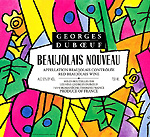At one past midnight on the third Thursday of each November, from little villages and towns like Romanèche-Thorins, over a million cases of Beaujolais Nouveau begin their journey through a sleeping France to Paris for immediate shipment to all parts of the world. Banners proclaim the good news: Le Beaujolais Nouveau est arrivé! "The New Beaujolais has arrived!" One of the most frivolous and animated rituals in the wine world has begun.
By the time it is over, over 65 million bottles, nearly half of the region's total annual production, will be distributed and drunk around the world. It has become a worldwide race to be the first to serve to this new wine of the harvest. In doing so, it has been carried by motorcycle, balloon, truck, helicopter, Concorde jet, elephant, runners and rickshaws to get it to its final destination. It is amazing to realize that just weeks before this wine was a cluster of grapes in a growers vineyard. But by an expeditious harvest, a rapid fermentation, and a speedy bottling, all is ready at the midnight hour. By French law, Beaujolais Nouveau is to be released no earlier than the third Thursday of November.
Beaujolais Nouveau began as a local phenomenon in the local bars, cafes, and bistros of Beaujolais and Lyons. Each fall the new Beaujolais would arrive with much fanfare. In pitchers filled from the growers barrels, wine was drunk by an eager population. It was wine made fast to drink while the better Beaujolais was taking a more leisurely course. Eventually, the government stepped into regulate the sale of all this quickly transported, free-flowing wine.
In 1938 regulations and restrictions were put in place to restrict the where, when, and how of all this carrying on. After the war years, in 1951, these regulations were revoked by the region's governing body, the Union Interprofessional des Vins de Beaujolais (UIVB), and the Beaujolais Nouveau was officially recognized. The official release date was set for November 15th. Beaujolais Nouveau was officially born. By this time, what was just a local tradition had gained so much popularity that the news of it reached Paris. The race was born. It wasn't long thereafter that the word spilled out of France and around the world. In 1985, the date was again changed, this time to the third Thursday of November tying it to a weekend and making the celebration complete. But wherever the new Beaujolais went, importers had to agree not to sell it before midnight on the third Thursday of November.
On a more technical note, the wine is strictly speaking, more properly termed Beaujolais Primeur. By French and European rules, a wine released during the period between its harvest and a date in the following spring, is termed primeur. A wine released during the period between its own and the following years harvest, is termed nouveau. Well, enough of that!
It is a triumph of marketing and promotion, mostly due to the efforts of Georges Duboeuf. The largest negociant in the region, he is a tireless promoter of Beaujolais and Beaujolais Nouveau. More than a fifth of his annual production, about 4 million bottles, is Beaujolais Nouveau. All in all, in the last 45 years, sales have risen from around a million bottles to more than 70 million bottles.






